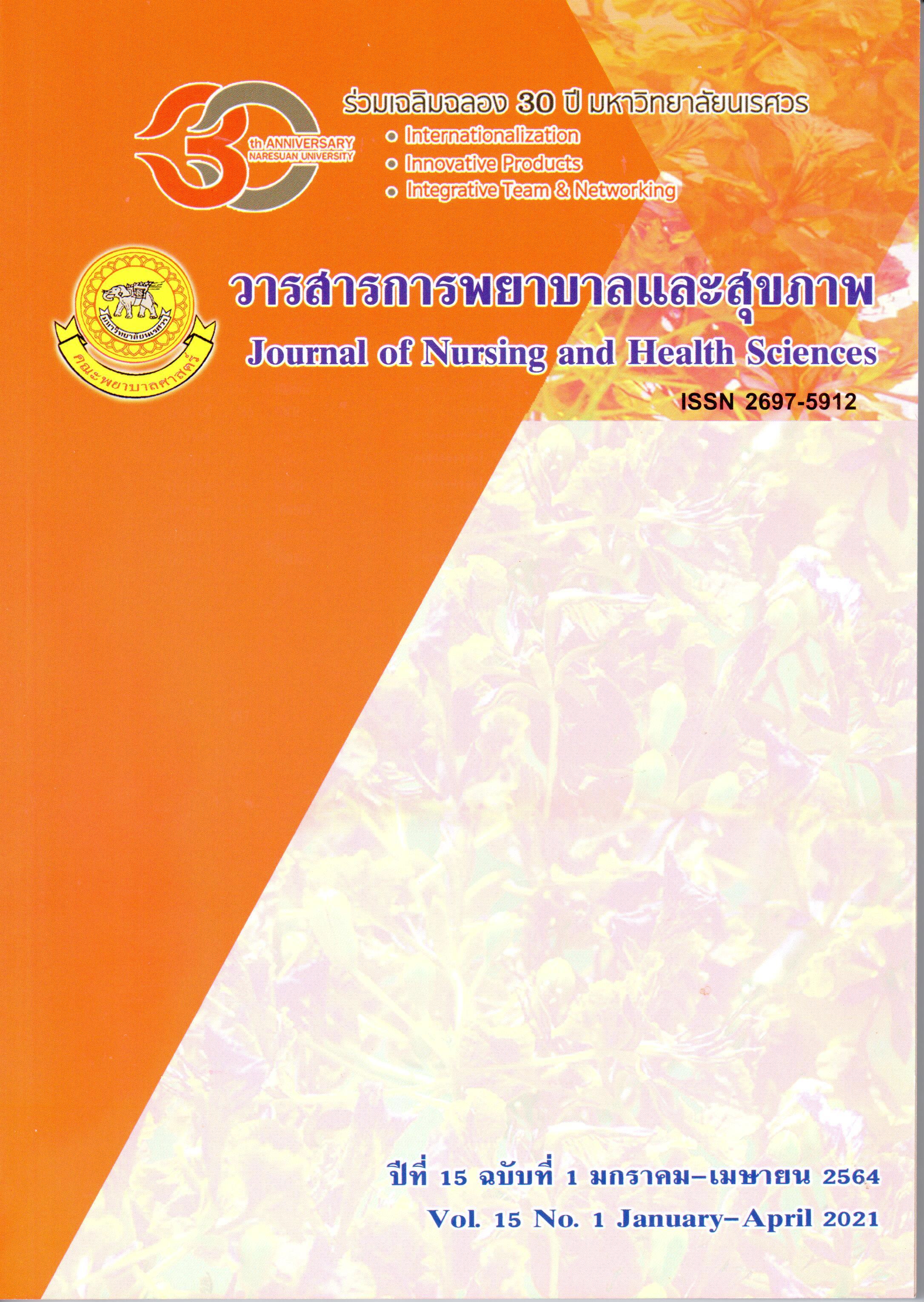การประยุกต์ใช้รูปแบบการปรับตัวของรอยสำหรับผู้ที่เป็นโรคหมอนรองกระดูกเคลื่อนทับเส้นประสาท: กรณีศึกษา
Main Article Content
บทคัดย่อ
โรคหมอนรองกระดูกเคลื่อนทับเส้นประสาท เป็นสาเหตุส่วนใหญ่ของกลุ่มอาการปวดหลังร้าวลงขาในบุคคลวัยผู้ใหญ่ ส่งผลกระทบให้ร่างกายเคลื่อนไหวลำบาก นำไปสู่ความพิการ สูญเสียรายได้และค่าใช้จ่ายในการรักษาจำนวนมาก รวมทั้งทำให้เกิดความเครียดหรือภาวะซึมเศร้า ผลที่ตามมาทำให้ผู้ป่วยต้องการปรับตัว รูปแบบการปรับตัวของรอยเป็นแนวคิดที่เน้นการส่งเสริมพฤติกรรมการปรับตัวต่อสถานการณ์ที่เป็นปัญหาของบุคคลหรือกลุ่มคน เพื่อให้มีชีวิตอยู่รอดในสิ่งแวดล้อมและอย่างมีคุณภาพชีวิต บทความนี้จึงมีวัตถุประสงค์เพื่อนำเสนอการประยุกต์ใช้รูปแบบการปรับตัวของรอยในกรณีศึกษาที่เป็นโรคหมอนรองกระดูกเคลื่อนทับเส้นประสาท เนื้อหาประกอบด้วย กรอบแนวคิดการปรับตัวของรอย กรณีศึกษาผู้ป่วยโรคหมอนรองกระดูกเคลื่อนทับเส้นประสาทในระยะก่อนผ่าตัด และการปฏิบัติการพยาบาลตามรูปแบบการปรับตัวของรอย ได้แก่ 1) การประเมินพฤติกรรมการปรับตัว 2) การประเมินสิ่งเร้า 3) การกำหนดข้อวินิจฉัยการพยาบาล 4) การกำหนดเป้าหมายการส่งเสริมการปรับตัว 5) การบำบัดทางการพยาบาล และ 6) การประเมินผล การประยุกต์ใช้รูปแบบการปรับตัวของรอยในกรณีศึกษานี้ พบว่า หลังให้การพยาบาลตามรูปแบบการปรับตัวของรอย ผู้ป่วยมีการปรับตัวอยู่ในขั้นต้องการชดเชย มีการปรับตัวดีขึ้นทั้งด้านร่างกายในหมวดสรีรภาพ ด้านอัตมโนทัศน์ และด้านบทบาทหน้าที่ กรณีศึกษานี้สามารถเป็นแนวทางให้พยาบาลนำรูปแบบการปรับตัวของรอยไปประยุกต์ใช้ในการพยาบาลผู้ป่วยที่มีความเจ็บป่วยอื่น เพื่อส่งเสริมให้ผู้ป่วยมีการปรับตัวที่ดี ส่งผลต่อคุณภาพชีวิตที่ดี
Article Details

อนุญาตภายใต้เงื่อนไข Creative Commons Attribution-NonCommercial-NoDerivatives 4.0 International License.
เอกสารอ้างอิง
Beasley, K. (2020). Herniated Nucleus Pulposus (Herniated, Ruptured, or Prolapsed Intervertebral Disk). Retrieved
February 12, 2020, from Lumbar disc. https://www.spine-health.com/conditions/spine-anatomy/lumbar-discs
Bunmaprasert T. (2013). Low back & neck pain, degenerative diseases of the spine. Chiang Mai: Orthopaedic
Department, Faculty of Medicine Chiang Mai University. [In Thai].
De Cicco, F. L, & Willhuber, G. C. (2020). Nucleus Pulposus Herniation. Retrieved August 10, 2020, from
https://www.ncbi.nlm.nih.gov/books/NBK542307/
Dang, S. (2018). When to Consider a Back Brace. Retrieved February 9, 2021, from
https://www.spine-health.com/treatment/alternative-care/when-consider-back-brace
Dydyk, A. M., Massa, R. N. & Mesfin, F. B. (2020). Disc Herniation. Retrieved April 25, 2020, from
https://www.ncbi.nlm.nih.gov/books/NBK441822/
Gautam, D. (2019). Nucleus Pulposus Herniation. Retrieved May 23, 2020, from
https://emedicine.medscape.com/article/1263961-clinical
Jantarungsi, N. (2017). Physical therapy in patients with Herniated Nucleus Pulposus. Hua Hin Sook Jai Klai
Kangwon Journal, 2(2), 1-16. [In Thai].
Jennings, K. M. (2017). The Roy Adaptation Model: A Theoretical Framework for Nurses Providing Care to Individuals with Anorexia Nervosa. Advance in Nursing Science, 40(4), 370-383.
Kongkasaem, C., Lagampan, S. & Chuengsaman, P. (2017). A program enhancing adaptation of patients with end stage renal disease and treatment by continuous ambulatory peritoneal dialysis. Journal of Public Health Nursing. 31(1), 75-89. [In Thai].
Kraiwattanapong, C. (2013). Lumbar disc herniation. In W. Tassanawipas et.al., (Eds), The textbook of the spine
(pp. 706-719). Bangkok: Spine Surgery, the Royal College of Orthopaedic Surgeons of Thailand. [In Thai].
Lertwatthanawilat, W. (2017). The documentation of the Update contemporary of nursing theories and
applications. Chiang Mai: Faculty of Nursing, Chiang Mai University. [In Thai].
Prompuk, B., Lertwatthanawilat, W., Wonghongkul, T., Sucamvang, K., & Bunmaprasert, T. (2018). Self-
Management among adults with chronic low back pain: A causal model. Pacific Rim International Journal of Nursing Research, 22(3), 223-236.
Prompuk, B., Tongkit, N., Junwijit, S., & Khunkaew, S. (2020). Effects of the inquiry method teaching on cognitive
skills and learning achievement of nursing students regarding the Roy Adaptation Model. The Boromarajonani College of Nursing Uttaradit Journal, 12(1), 92-106. [In Thai].
Roy, C. (2009). The Roy Adaptation Model (3rd ed.). United Kingdom: Pearson Education.
Roy C. (2011). Extending the Roy Adaptation Model to Meet Changing Global Needs. Nursing Science Quarterly, 24,
-51.
Roy C. (2018). Roy’s Adaptation Model. Retrieved February 12, 2020, from:
https://nursology.net/nurse-theorists-and-their-work/roys-adaptation-model/
Simoens, F. (2020). Disc herniation. Retrieved April 25, 2020, from https://www.physio-pedia.com/Disc_Herniation
Shanti, N. (2021). The best sleep position for back pain relief. Retrieved February 8, 2021, from
https://www.shantispinesurgery.com/best-sleep-positions-for-back-pain-relief/
Tristate Pain Institute, (2020). Sleeping with a herniated disc. Retrieved February 8, 2021, from
https://www.tspain.com/blog/sleeping-herniated-disc
Thongrung, S., Suntayakorn, C,. Juntarawijit, Y. & Prachanban, P. (2013). The effects of adaptation program on activities
of daily living and quality of life among stroke patients. Journal of Nursing and Health Sciences. 7(3), 88-97.
[In Thai].
Thosingha, O., Tengpanichkul, P., Chuetaleng, T., & Thongteratham, N. (2015). Orthopedic nursing. Bangkok:
NP Press.
Uesavas, F. E., Karayurt, O., & Iseri, O. (2014). Nursing approach based on Roy Adaptation Model in a patient
undergoing breast conserving surgery for breast cancer. Journal of Breast Health, 10(3), 134-140.


